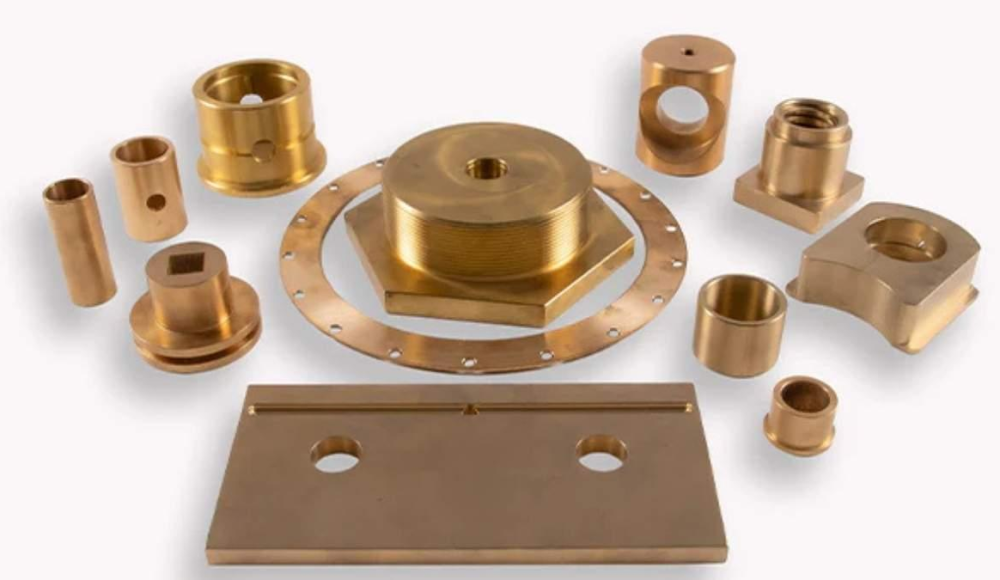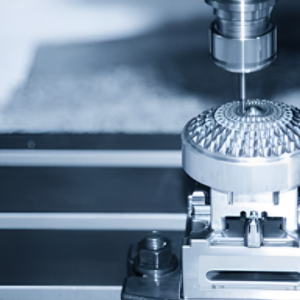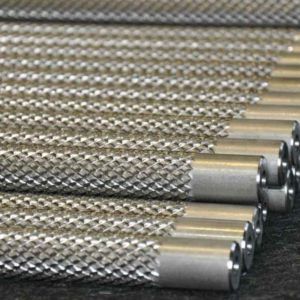A liga de bronze proporciona um desempenho incrível. Estes são frequentemente usados em maçanetas e medalhas, mas suas aplicações não terminam aqui. Além disso, bronze é usado em componentes de motores, ferramentas, e bombas. Além disso, é vitalmente empregado em sinos e fontes ornamentais de navios.
Compreendendo o Bronze
O metal bronze é geralmente encontrado em uma cor marrom-avermelhada pertencente ao grupo “metal vermelho”. Contém 88% cobre e 12% estanho; é relativamente flexível e tem muitos usos industriais. Adicionalmente, a liga é mais dura que o cobre puro, facilitando os processos de fabricação. O baixo contato metal-metal melhora sua aplicabilidade em diferentes indústrias. Às vezes, ingredientes como fósforo ou zinco melhoram as características do bronze. Fundição significa a fusão do bronze, a adição de outros materiais e depois o resfriamento em moldes de núcleo.
Tipos de metal bronze
Bronze abrange cerca 50 tipos distintos de liga. Para ser breve, aqui estão cinco variedades comuns na fabricação:
| Tipo Bronze | Composição (Elementos Adicionais) |
| Alumínio Bronze | 6–12% alumínio |
| Níquel Alumínio Bronze | 6–13% alumínio, até 7% ferro, 7% níquel |
| Bronze Silício | Até 6% silício |
| Bronze Fósforo | Até 11% estanho, 0.35% fósforo |
| Bronze Manganês | Até 3% manganês |
Propriedades Físicas do Bronze
Abaixo estão as principais propriedades físicas do bronze:
| Propriedade | Descrição |
| Densidade (g/cc) | 5.60 – 9.30 |
| Cor | Castanho-avermelhado metálico |
| Ponto de fusão (°C) | 315 – 1180 |
| Ponto de ebulição (°C) | 1400 |
| Condutividade térmica (W/m-K) | 1.01 – 208 |
Propriedades Químicas do Bronze
O bronze exibe várias características químicas importantes:
| Propriedade | Descrição |
| Resistência à corrosão | Bom |
| Condutividade elétrica | Bom |
| Produtos de oxidação | Óxido de cobre, carbonato |
| Magnético | Não |
| Maleabilidade | Bom |
| Ductilidade | Alto |
Ligas de bronze comuns
As ligas de bronze comuns são discutidas abaixo:
Bronze de alumínio
O bronze de alumínio contém alumínio em volta 9 para 14%. Possui alta resistência, colheita, resistência à abrasão, e características mecânicas. O bronze de alumínio é ideal para indústrias marítimas porque é resistente à água salgada, e álcalis. Os produtos incluem hélices, válvulas, e inúmeras outras peças de navios. Também serve para engrenagens e rolamentos. A força é semelhante a 50-55 HRC de aço médio carbono.
Alguns exemplos gerais de bronze de alumínio incluem:
- C95400 (Alumínio Bronze)
- C95500 (Bronze de alumínio com chumbo)
- C95800 (Bronze de alumínio de alta resistência)
- C95900 (Bronze de alumínio com níquel)
Níquel Alumínio Bronze
O níquel-alumínio apresenta propriedades de níquel e alumínio. Esta liga oferece excelente desempenho contra corrosão em ambientes distintos. No entanto, a resistência à corrosão é maior que a do 300 série de aço inoxidável. Além do mais, é adequado para aplicações marítimas e aeroespaciais. A flexibilidade do bronze níquel Ni-Al é um ponto forte, especialmente em soldagem.
Alguns exemplos gerais de bronze de níquel-alumínio incluem:
- C95400 (Níquel Alumínio Bronze)
- C95500 (Bronze de alumínio níquel com chumbo)
- C95800 (Bronze de alumínio níquel de alta resistência)
- C95900 (Níquel Alumínio Bronze com Manganês)
Bronze de estanho
O bronze de estanho é uma antiga liga de bronze, geralmente caracterizado por características de fundição e anticorrosivas razoavelmente boas. Tem estanho até 12% portanto, usado para engrenagens e rolamentos. No entanto, adicionar Estanho Bronze ao projeto de usinagem pode elevar o custo total do material a ser utilizado na fabricação de produtos eletrônicos.
Alguns exemplos gerais de bronze de estanho incluem:
- C90200 (Bronze de estanho)
- C90300 (Bronze de estanho com chumbo)
- C90500 (Bronze de alto estanho)
- C90700 (Bronze de alumínio-estanho)
Bronze Manganês
O bronze manganês é altamente resistente à corrosão da água do mar, com resistência à tração máxima atingindo 110,000 PSI. Os usos usuais são nos rolamentos, engrenagens, e hélices usadas em embarcações marítimas.
Alguns exemplos gerais de bronze manganês incluem:
- C86300 (Olá, tração)
- C86400 (Manganês com Chumbo)
- C86500 (Baixa elasticidade)
- C86200 (Med Elástico)
Rolamento Bronze
Bronzes de estanho com alto teor de chumbo são empregados em rolamentos e buchas. As ligas acima mencionadas são relativamente baratas e eficientes em termos de funcionalidade. LCR está conectado ao conteúdo de estanho. A distribuição de chumbo melhora a força, lubricidade, e conformabilidade. O bronze do rolamento pode operar a 450°F / 230°C. Sua capacidade de carga é de cerca 4,000 PSI.
Alguns exemplos gerais de rolamentos de bronze incluem:
- C93200 (Bronze de estanho)
- C93700 (Bronze de estanho com chumbo)
- C94300 (Alumínio Bronze)
- C90500 (Bronze de alto estanho)
Bronze versus. Latão: Principais diferenças
Bronze e latão são distinguidos principalmente com base em sua constituição e propriedades. Ambos são ligas de cobre e não são facilmente corroídos. No entanto, o bronze desenvolve uma camada de óxido em sua superfície à medida que envelhece. Por outro lado, sabe-se que o latão tem a característica de manchar lentamente.
O latão é uma liga que contém cobre, zinco, e alguns outros ingredientes. Esses aspectos determinam a cor desse tipo de metal que pode ser dourado ou prateado brilhante.. O latão pode ser moldado com mais facilidade do que o bronze, portanto é mais dúctil. Esta propriedade faz com que o latão seja forte o suficiente para ser martelado e laminado sem quebrar..
Processo de Fabricação de Bronze
O bronze tem sido importante no desenvolvimento de ferramentas e armas há séculos. O processo de produção do material é complexo, mas simples. Esta liga rígida é preparada aquecendo o estanho e o cobre puro quando atingem o ponto de fusão.. Os gases misturados devem então ser resfriados e refinados e a mistura fundida deve ser despejada em moldes de argila e deixada esfriar.. Abaixo estão os principais processos de fabricação relacionados ao bronze:
Usinabilidade de Bronze
A usinagem de bronze para rolamentos pode produzir bons resultados se for feita de maneira eficaz. Ao usinar projetos, o uso de refrigerante ou lubrificante melhora a qualidade da superfície do produto acabado. Porque embora tenha grande resistência o risco deve ser tomado com cuidado durante as operações. Por exemplo, velocidades mais baixas são recomendadas durante o alargamento devido ao “agarramento”.
Resistência à corrosão de bronze
O bronze tem um nível incrível de corrosão, e pode ser usado em condições onde outros metais não podem sobreviver, como em água salgada. Possui um acabamento exclusivo que pode ser polido até ficar brilhante ou retido para produzir um acabamento exclusivo., aparência levemente enferrujada.
Recozimento de Bronze
O bronze não é fácil de recozer e aliviar o estresse. Então, o recozimento do bronze deve ser feito cuidadosamente por meio de aquecimento. É crucial manter a temperatura durante uma hora por polegada de espessura da parede em 260 C. Isso não pode ser feito em um ritmo rápido ou então pode desmoronar, e fratura. Trabalhando em bronze de silício que possui maior porcentagem de chumbo, requer cuidado extra, e medidas necessárias, como o uso de roupas de proteção adequadas e as metodologias de extração corretas, devem ser observadas.
Fundição de Bronze
A fundição de bronze tem sido usada para produzir obras-primas de metal derretido há séculos. Isso inclui fazer instrumentos musicais, esculturas, prêmios, etc que usam processos como cera perdida, conchas de cerâmica, ou areia. Os artesãos seguem um processo delicado e usam diferentes técnicas para despejar bronze derretido em moldes e criar obras de arte substanciais..
Formabilidade e Ductilidade
Como a maioria dos metais, o bronze também pode ser formado em baixas temperaturas para melhorar sua resistência e rigidez. As propriedades de baixo atrito do bronze para rolamentos o tornam adequado para uso em diversas aplicações. Por exemplo, o Bell bronze produz sons ressonantes, e muitas das outras ligas de bronze apresentam excelente resistência à corrosão pela água do mar.
Mais importante ainda, bronze é dúctil, e é possível transformá-lo em fios finos sem que ele se quebre. Esta característica é especialmente útil em geradores em todo o mundo, comprovando as capacidades do metal.
Vantagens do Bronze
- A resistência é maior que a pureza do cobre ou do ferro.
- Um grande nível de resistência à corrosão melhora sua durabilidade.
- Maior calor e condutividade elétrica do que a maioria dos tipos de aço.
- A resistência à fadiga parece ser superior à de muitas ligas.
- O derretimento é maior, portanto a fundição é mais fácil.
- Também é importante dizer que o baixo atrito metal-metal é uma vantagem em aplicações mecânicas.
- Usabilidade total, e eficiência nas diversas aplicações para as quais é utilizado.
- Fornece um revestimento de superfície de alta qualidade.
Desvantagens do Bronze
- O bronze é mais sujeito à oxidação do que sua liga, latão.
- Às vezes é ainda mais caro que o aço, latão, ou cobre.
- O composto é suscetível à deterioração por compostos férricos e amônia.
- Danos por enxofre e cloro podem ser acelerados por circunstâncias úmidas.
- A doença de bronze pode se desenvolver, evidenciado por manchas verdes claras na pele.
- Se esta condição não for resolvida, leva a uma deterioração grave.
Conclusão
Resumindo, o bronze merece ser chamado de um escalão de tipos de ligas inventivas e resilientes. Possui uma gama de propriedades mecânicas desejáveis e resistência à corrosão. Mesmo que tenha seus deméritos, que incluem altos custos e sensibilidade a certas condições ambientais, as vantagens que resultam da implementação desta abordagem são mais vantajosas. Por último, fica claro que o bronze continua sendo um material essencial na fabricação, um indicador claro de sua relevância. Contate-nos Para maiores informações.
Perguntas frequentes
1. Como funciona a adição de estanho (Sn) mudar cobre (Cu) para criar Bronze?
A adição de estanho (Sn) altera fundamentalmente as propriedades mecânicas do cobre (Cu) através fortalecimento de solução sólida. O cobre puro é muito macio e maleável. Ao introduzir átomos de estanho na rede cristalina de cobre, os átomos de estanho distorcem a estrutura regular. Essa distorção torna significativamente mais difícil para os planos atômicos deslizarem uns pelos outros, resultando em bronze tendo maior dureza, maior resistência à tração, e resistência superior ao desgaste comparado ao cobre puro.
2. O que é “Doença do Bronze”,” e por que é uma preocupação significativa com artefatos?
Doença de Bronze é um específico, forma destrutiva de corrosão que afeta principalmente artefatos de bronze antigos, especialmente aqueles expostos à umidade e cloretos (por exemplo., da água do mar ou do solo). É uma reação autocatalítica onde cloreto cuproso (CuCl) reage com água e oxigênio para formar ácido clorídrico (HCl), que por sua vez corrói mais cobre. Parece pulverulento, manchas verdes claras. Se não for tratado, esta condição pode se espalhar rapidamente e desmoronar e destruir completamente o objeto de bronze.
3. Por que o alumínio é bronze (Al-Bronze) especificamente favorecido para uso em ambientes marinhos?
O Bronze de Alumínio é preferido para aplicações marítimas porque o teor de alumínio faz com que a liga forme espontaneamente uma substância altamente estável., afinar, camada superficial protetora de óxido de alumínio (Al2O3). Esta camada é extremamente resistente à corrosão, especialmente os efeitos corrosivos água salgada (íons cloreto) e ácidos suaves, oferecendo melhor desempenho do que muitas outras ligas à base de cobre em componentes de navios, válvulas, e hélices.
4. Como lidera (Pb) melhorar o desempenho do “Rolamento Bronze”?
O chumbo é adicionado aos bronzes de estanho (bronzes de estanho com alto teor de chumbo) para melhorar seu desempenho como materiais de rolamento. O chumbo não se liga à matriz de cobre/estanho; em vez de, permanece como pequeno, partículas macias finamente dispersas. Este conteúdo principal oferece dois benefícios principais:
-
Lubricidade: As partículas macias de chumbo atuam como um lubrificante sólido, reduzindo o atrito e evitando o contato metal com metal.
-
Conformabilidade: O cabo macio permite que a superfície do rolamento se adapte ligeiramente às irregularidades do eixo, evitando superaquecimento localizado e convulsão.
5. Qual é a principal diferença funcional entre Latão e Bronze em aplicações de engenharia?
| Recurso | Latão (Cu + Zn) | Bronze (Cu + Sn) |
| Propriedade Primária | Excelente usinabilidade (fácil de cortar/formar) | Alta Dureza, Força, e resistência ao desgaste |
| Usos comuns | Acessórios de encanamento, hardware decorativo, instrumentos musicais. | Rolamentos, engrenagens, válvulas, hélices marítimas, e fundições estruturais. |
| Resistência | Mais dúctil (mais fácil de deformar). | Mais resistente, mais adequado para condições abrasivas e de alta carga. |
6. Por que é recomendada uma velocidade mais baixa durante o alargamento de ligas de bronze??
Velocidades mais baixas são recomendadas durante o alargamento (um processo de acabamento de furo) de algumas ligas de bronze, particularmente aqueles que contêm chumbo ou alto teor de estanho, para evitar um fenômeno conhecido como “agarrando”. As ligas de bronze podem ser relativamente pegajosas ou macias em comparação com o aço, e operar o alargador muito rápido pode fazer com que a ferramenta morda agressivamente o material, potencialmente causando vibração, acabamento superficial ruim, ou quebra de ferramenta. Velocidades mais lentas permitem um limpador, corte controlado.
7. A que se refere o termo “LCR” no contexto da composição do Bearing Bronze?
No contexto do rolamento de bronze (como C93200), LCR muitas vezes significa Proporção de cobre com chumbo ou mais genericamente refere-se ao Liderar, Cobre, e Residual conteúdo do elemento. A presença e distribuição precisa de chumbo (Pb) em relação à matriz de cobre e estanho são parâmetros críticos que definem as capacidades de lubrificação e antifricção da liga.




1 pensei em “Tudo sobre metal bronze”